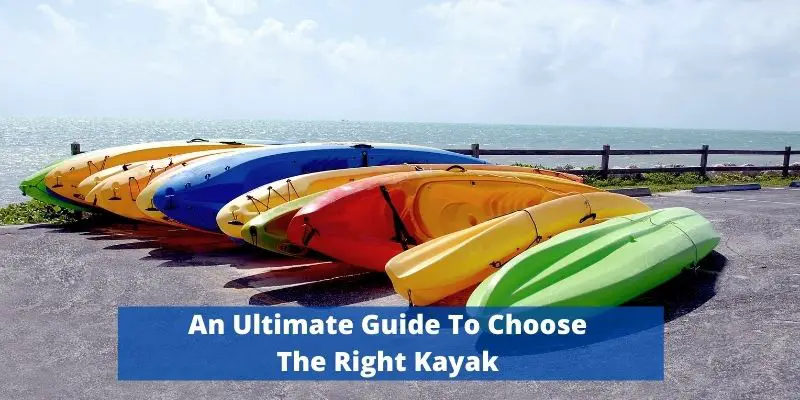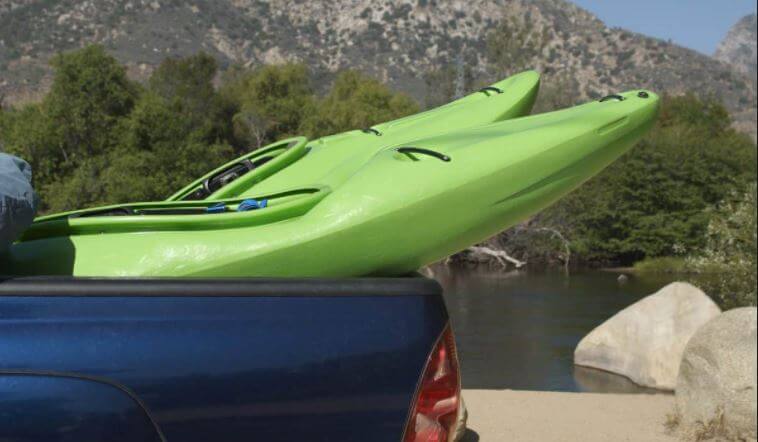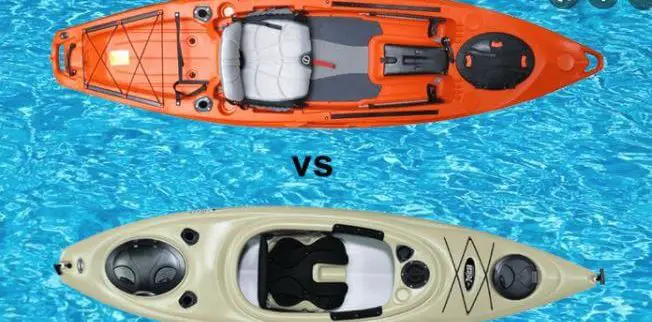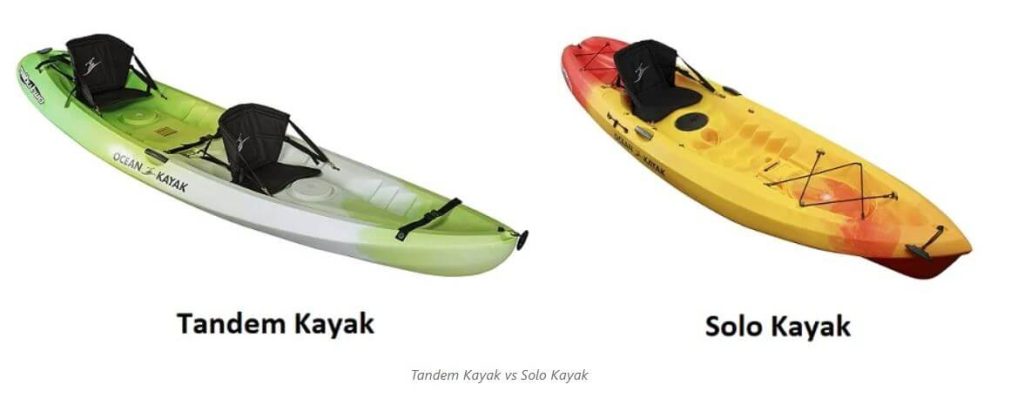The kayak market is vast, and it can be hard to know where you’ll find the perfect one. Pouring over the market and going through hundreds of different models is enough to give anyone a headache. It’s not easy finding your perfect kayak.
I remember looking for my first one as well- it felt like an impossible task in front of me.
What kayak is right for me? Don’t worry! We’ve got your back covered with a guide for finding the right kayak.
Choosing the right kayak can be overwhelming. I’ll show you how to find your perfect fit and help take care of all those pesky details so that this process goes smoothly.

Choosing A Kayak For Beginners – What Kayak Is Right For Me?
To find the perfect kayak, you need to ask yourself a few questions.
Step # 01 – Where Do You Want To Paddle
Begin by thinking about how you plan on using and exploring water types in general (fast rivers, slow-moving lakes). Once that is clear-cut, look at what type of kayak best suits these needs based on those ideas from before.
Lakes
If you want to take on lakes with ease and leisure, a recreational kayak is the best option. These sit-on designs are designed for those who enjoy exploring at their own pace.
Rivers
A kayak can be the perfect way to explore rivers, but no one-size-fits-all when it comes down to choosing which type. The best choice for you will depend on your personal preference and what kind of river trip suits them most: slow-moving or intense whitewater rapids?
If you are new to kayaking, a recreational kayak might be the best choice. These generally fit for river paddlers as long as they don’t plan on running rapids which would require an extra special kind of kayak called “Whitewater Kayak.” I recommend that beginners stay away from his type of recreational canoe/kayak until their skills have improved much.
Ocean/Sea Waters
The open waters might seem tranquil but don’t be fooled—choppy conditions are frequent as these waters are exposed to winds. Touring kayaks are the best choice for those who want to enjoy open water adventure. Touring kayaks are better at tracking (ability to go straight) in these conditions as well as being more buoyant than other types of boats; which makes them ideal for rough seas.
Step #02 What Purpose You Are Gonna Use It
What are you looking for in a kayak? Do your needs revolve around recreation or touring, whitewater rapids and calm lakes, fishing, or racing?
There are many different types of kayaks to choose from, and not all will suit your needs. The best way is by knowing what type you’re looking for beforehand:
- Recreational kayaks offer solid all-around performance and stability that make them ideal when heading out across calm waters at any skill level.
- Touring kayaks are designed for long-distance paddling and multi-day trips. They are perfect vessels to explore the hidden places, as their sleek designs allow you to cover more ground in less time than other kayaks.
- Whitewater kayaks are designed to face aggressive waters. The shorter hulls and enhanced rocker profiles of these kayaks make them ideal for tricky water environments where control is key to success.
- Fishing kayaks are a great choice for avid anglers. These boats offer the stability and capacity that you need in an ample fishing trip, as well as compatibility with fishing accessories designed specifically to make your time on water more enjoyable.
- A hunting kayak is a great alternative to the traditional Jon boat you might use. They can handle rough seas and are designed for both fishing and hunting.
- Racing kayaks are made for high-speed water and offer a unique experience. They’re long, narrow, lightweight composite vessels that come with an experienced paddler in mind; they can be reserved only by those who know how to use them well enough because of their fast speeds.
Step#03 Transporting & Storing Your Kayak

It might seem like an off-the-wall question, but it comes down to deciding whether you want a hardshell or inflatable kayak.
A hard-shell kayak can weigh anywhere from 40 pounds to over 100 which is more than the average person carries on their back. Inflatable ones, on the other hand, are usually 25 – 30 lbs that pack into duffle bags on your back.
Owning a kayak also means carrying it, transporting it to and from the water (or any remote location), storing it in an appropriate area. It is important to consider the weight and dimensions before triggering a purchase.
Read: How To Store A Kayak Properly
Step# 04 Sit on Top Or Sit Inside

The choice is up to you regarding what style of paddling and the environment that will be experienced. Comfortability should also factor in when considering your preferences for this activity.
Let’s have look at both the options
- Sit on Top features an open deck with self-bailing scupper holes, making the ride more comfortable and easier to get in and out. It offers a quite user-friendly ride for newbies. Kayak anglers prefer to use sit-on-top kayaks because they are more stable, comfortable and offer better movement.
- Sit-inside kayaks are the best choice if you want a more protected paddling experience or greater control in challenging environments. These closed cockpits will keep water from reaching your body. A spray skirt would enhance the protection element while paddling. If you want better control and efficiency for long-distance paddling, get up and go wherever the water takes you with a sit-in model.
How You Want To Propel Your Kayak
The kayak’s propulsion method is one of the many factors that determine its price tag, versatility, and convenience. It can make for more than a preference when you weigh these out against each other with your needs in mind.
- Paddles are the king of on-the-water kayaks. They provide a more traditional experience for those who want nothing but pure relaxation as they glide through calm waters, listening to nature sing with each stroke from their paddle blade.
- For those of you who need a break from all the arm work, pedal drive systems are an excellent alternative that turn kayaking into a cycle riding fun. It lets your leg muscles do some of that pedaling for ya while saving your energy and providing a faster ride.
- Motor driven kayaks often called trolling motors powered by batteries allow kayakers to experience speed and range that they could never achieve through traditional means. Plus this type of propulsion is perfect for those who may find it difficult pedaling or paddling.
Solo Or Tandem Kayak

Some people enjoy kayaking alone and, for these solo hobbyists a single-person kayak is the best option.
While some like to enjoy sharing that experience with a friend or loved one or even kids. In case you are looking for something on the cheaper end of things, buying a tandem kayak would be more ideal than two individual ones since they cost less and can still provide some fun.
If you’re stranded between trying out both solo and tandem kayaking, take a look at sit-on-top (SOT) models that offer both tandem and solo configurations.
Kayak Specs & Features To Be Considered – How To Pick A Kayak
In this section, you will find the kayak’s specs and features that will help determine if it is a good fit for your needs.
So let’s go ahead.
Kayak Brand – Does Kayak Brand Matter
As soon as you start finding the market, there would be many brands to choose from. This makes it difficult for someone who is new and doesn’t know what they exactly want.
And you’d be asking yourself, Do I need a branded kayak?
The answer is yes! You’ll get a better product if you buy from a reputable company, and there are several benefits to this even if costs you some extra bucks.
Here’s what the best kayak brands offer:
Reputation: Some kayak manufacturers are known for their high-quality products and excellent customer service. One reason why these companies have such a great reputation is that they put effort into making innovative, well-built boats that will withstand even the most rigorous conditions with ease while still providing comfort in any situation.
Safety Standards: The safety and reliability of your vessel rely heavily on how it is manufactured. Safety standards are met with national and international certification along with quality control measures in place to ensure your vessel’s reliability.
Warranty: Warranty policies can give you valuable information about kayak manufacturers, like the company’s stance on customer service. If they offer warranties or at least provide return tags if anything goes wrong in shipping – this will increase how much confidence consumers might have when purchasing from them and whether or not these are reliable companies worth working with long-term.
Check: Best Kayak Brands
Kayak Length – What Is The Right Size Kayak For Me
When deciding on the appropriate kayak length, you must remember that length affects handling and other aspects of your kayak’s performance.
Kayak classes are broken down by length. Shorter kayaks are easier to turn, agile, and maneuverable – while longer ones provide faster speeds with efficient tracking performance.
Check out our Kayak Sizing Guide.
Kayak Width
A wide kayak will offer you more stability in waters, but make sure that it’s not too big or bulky because they are slower than normal ones.
So, How wide a kayak should be?
The answer to this question depends on the type of kayaking you plan to do and if your preference is for primary or secondary stability. The average recreational ‘yak has a beam that ranges anywhere from 28 inches up to 34 inches.
If you want to opt for initial stability, go with a beam that ranges 30-42 inches as in fishing kayaks. If secondary stability is your preference as in touring kayaks, go with a beam that measures less than 28 inches.
Kayak Weight
Carrying a kayak requires some careful planning because the weight will tire even someone in good shape after a few minutes or so with their kayak on shoulder duty.
Kayaks can be a pain to carry, especially if you plan on taking your kayak out in the water. A lot of these fishing or touring kayaks weigh between 20 and 80 pounds – but some go past 100 lbs (when fully rigged for fishing).
You might consider an inflatable kayak if you want to go places that involve a lot of portaging, or one with lighter materials.
Make sure you are comfortable with the weight of your kayak before loading it up or else be prepared for some heavy-duty labor.
Kayak Weight Capacity
You need to take your body weight into consideration first, but the total weight of your cargo is important. Think about all the supplies and equipment that you bring on board for a journey, as well any clothes or other possessions like water bottles – every ounce counts.
The 200-pound weight rating means that it can carry a total of 200 pounds (not a 200 pounds person) and stay afloat.
The extra weight will decrease stability and maneuverability, which may lead it to sit lower in water. When it comes to kayaks, the rule of thumb is always to stay below your rated capacity by roughly 30-40%.
Read Our Guide To Kayak Weight Capacity
Kayak Material
The most common materials used in the construction of a hard-shell kayak are:
Polyethylene plastic is the most common material used for making rotomolded kayaks. Polyethylene has many benefits including impact resistance and reasonable cost, but one downside is it can permit UV damage which makes them more prone to wear and tear.
ABS plastics are an affordable material that can be used in making thermoformed boats. These are lighter than Tupperware kayaks and crafts provide better UV resistance and value relative to their counterparts at half of their cost when considering only price points.
Composites: Fiberglass, Kevlar, and carbon fiber-made kayaks have outstanding performance on the water. Fiberglass is fantastic for its lightweight while still providing a great strength-to-weight ratio. It’s expensive though, but that shouldn’t be a deal-breaker as these kayaks are worth every penny.
Storage Space And Mounts
The storage solutions in a kayak are fundamental to its functionality. With specialized sea or fishing kayaks, you’ll need more than just basic gear and stowage; thus it becomes crucial that your kayak has room for all those additional items. To get started I would recommend thinking about how much space you expect on average between each item while out paddling – this includes not only necessities such as food, water, and clothing but also lifejackets.
If your only plan is an hour-long paddle, then there’s no point in buying a kaya that costs more because of all the extra storage hatches – they won’t be used.
Similarly, it is pointless to take multi-day trips with a touring kayak that doesn’t offer ample storage.
Most people start by looking at the storage and mounting options. There are plenty of different ways that you can go, but it comes down to a matter of preference- as long as your needs are met. But one must look for the following
- Bungee riggings and lacings
- Mesh pockets
- Watertight sealed hatches
- Tie downs
- Storage areas at bow and stern
- Molded-in recess
- Paddle holders
- Rod holders (for a fishing kayak)
How To Choose A Kayak As A Beginner – Wrapping Up
If you’re wondering what kayak should I choose, forget about this one universally fitting boat that every other person tells me about. The key question should be: “What kayak is right for me?
